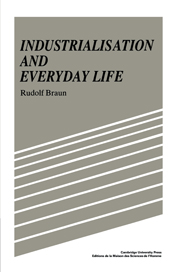Book contents
- Frontmatter
- Contents
- Prefaces
- Acknowledgements
- Note on measures and coinage
- Introduction
- 1 The preconditions for industrialisation
- 2 Changes to the structure of family and population in the industrial regions
- 3 Life and society of the population engaged in industry
- 4 The impact of industrialisation on the house and the rural economy
- 5 Work in the putting-out industry and its effect on the life of the common people
- 6 The outworkers' attitude to poverty and crises
- 7 Conclusion
- Postscript
- Appendix: a note on the administrative structure and social stratification in the countryside of Zurich during the Ancien Régime
- Notes
- Sources and bibliography
- Index
Appendix: a note on the administrative structure and social stratification in the countryside of Zurich during the Ancien Régime
Published online by Cambridge University Press: 16 March 2010
- Frontmatter
- Contents
- Prefaces
- Acknowledgements
- Note on measures and coinage
- Introduction
- 1 The preconditions for industrialisation
- 2 Changes to the structure of family and population in the industrial regions
- 3 Life and society of the population engaged in industry
- 4 The impact of industrialisation on the house and the rural economy
- 5 Work in the putting-out industry and its effect on the life of the common people
- 6 The outworkers' attitude to poverty and crises
- 7 Conclusion
- Postscript
- Appendix: a note on the administrative structure and social stratification in the countryside of Zurich during the Ancien Régime
- Notes
- Sources and bibliography
- Index
Summary
The territory of the canton of Zurich was acquired by the town of Zurich during the late Middle Ages mostly through purchase or mortgaging by declining feudal powers. During the Reformation a vast amount of church property was secularised and seized by the town. The latter was ruled by two town councils (a large and a small one, the latter being the governing body) with two Mayors at its head. It is the small council which is usually addressed as Your Worship in the sources quoted by the present book. The rural territory was administered by governors (Land-and Obervögte for the secular property, Amtsmänner for former church property; the translation invariably uses the term governor) chosen from among the members of the town council for a limited period of years.
On the local level, a clear distinction must be made between the village community and the church parish. The latter often encompassed several villages and, particularly in the Oberland, hamlets and scattered farmsteads not belonging to a commune. Its chief officer was the minister who, from the late sixteenth century onwards, had to be a burgher of the town of Zurich. He and the church eiders (Ehegaumer) chosen from among the parishioners formed a supervisory body (the Stillstand) watching over the moral life in the parish and administrating church funds, particularly with regard to Poor Relief.
The intermediary between the village community and the political administration represented by the governor was the bailiff (in the sense of an administrator; Untervogt) who usually was a member of the local upper class, i.e. a wealthy farmer.
- Type
- Chapter
- Information
- Industrialisation and Everyday Life , pp. 193 - 194Publisher: Cambridge University PressPrint publication year: 1990

